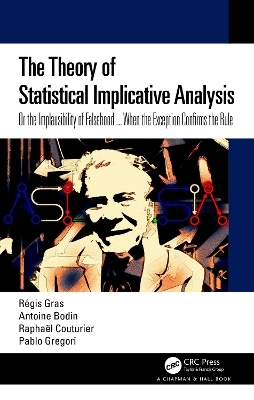
The Theory of Statistical Implicative Analysis
Chapman & Hall/CRC (Verlag)
978-1-032-51542-7 (ISBN)
This book summarizes the methods and concepts of Statistical Implicative Analysis (SIA), created by Régis Gras in the 1980s to study, in a new way, the behavioural responses of French pupils to mathematics tests. Using a multidimensional, non-symmetrical data analysis method, SIA crosses a set of subjects or objects with a set of variables. It effectively complements traditional correlational and psychometric methods.
SIA, through its various extensions, is today presented as a broad Artificial Intelligence method aimed at extracting trends and possible causalities in the form of rules, from a set of variables. It is based on the unlikeliness of the existence of these relationships, i.e. on the relative weakness of their counter-examples compared to what chance alone would produce. It establishes a dual topological relationship between the set of subjects and the set of variables. Many applications of this approach, driving forces or crucibles for the development of SIA, have concerned and still concern various fields such as didactics, evaluation and assessment, psychology, sociology, medicine, biology, economics, art history, and others.
Key Features:
Presents the foundations and representations of SIA
Provides extensions of variable sets and subjects
Includes a bonus exercise
Régis Gras was a Professor Emeritus at the Ecole Polytechnique of the University of Nantes. He was the founder of all the methods and tools of Statistical Implicative Analysis, and continuously developed extensions in the context of data mining alongside his team. He was President of the French Commission for the Teaching of Mathematics (1995-1998), then member of the committee on teaching of the European Mathematical Society (1997-2003). He authored and supervised eight books, six educational films, and was the co-editor of multiple book chapters. Antoine Bodin has worked successively or simultaneously as a mathematics teacher, teacher trainer and researcher in mathematics didactics. As an expert and consultant for various national and international organizations, he is specialized on school curricula and assessment matters. For over 40 years, Antoine Bodin has contributed to the development of Statistical Implicative Analysis. Raphaël Couturier received his Ph.D. degree in computer science from the University of Lorraine, France, in 2000. He worked as an Assistant Professor at the University of Franche Comté (UFC) from 2000 to 2006. Since 2006, he has been working as a Full Professor at UFC. His research area covers various topics such as parallel algorithms for HPC or GPU, applied security, IoT, machine learning and deep learning. In 2007, he coauthored a book entitled Parallel Iterative Algorithms: From Sequential to Grid Computing. In 2013, he was the Editor of a book entitled Designing Scientific Applications on GPUs. Raphaël has already written more than 150 papers in international peer-reviewed journals and conferences. He is currently Vice-President of digital in UFC. Pablo Gregori is an Assistant Professor of Statistics and Operations Research at Universitat Jaume I de Castellón. His primary research covers spatial statistics (Point Processes and Geostatistical Processes) and data mining (Statistical Implicative Analysis and its relations with Association Rules). He has also published papers in Mathematics Education and Functional Analysis.
1. Paradigmatic overview of Implicative Statistical Analysis. When? Why? How? 2. From the founding situations of the SIA to its formalization 3. Extension of the Statistical Implicative Analysis to rule hierarchies 4. Dual relationships between subject and space of variables in Implicative Statistical Analysis Part 1: Extension of sets of variables and subjects 5. Multivariate variables with Statistical Implicative Analysis 6. Superfluous or redundant rules in SIA 7. Rule Extraction on Fuzzy Sets 8. Extension of Statistical Implicative Analysis to a continuous population space 9. Extension of SIA to the case of continuous variables Rev1: Pablo (FINIE) Rev2: Antoine (FINIE) Part 2: The SIA and the cognitive development 10. Hierarchies of rules and conceptualization 11. SIA, Analyzer and Revealer of Taxonomic Complexity Part 3: D-Slanted views: fractal geometry, formal logic, rational mechanics 12. Fractal dimension of an implicative graph 13. The paraconsistent logic of Implicative Statistical Analysis 14. A mechanical metaphor of the implicative graph of Implicative Statistical Analysis Part 4. Bonus Question 15. Exercise: a numerical example for didactic purposes
| Erscheinungsdatum | 05.12.2023 |
|---|---|
| Zusatzinfo | 29 Tables, black and white; 30 Line drawings, color; 18 Line drawings, black and white; 1 Halftones, color; 31 Illustrations, color; 18 Illustrations, black and white |
| Sprache | englisch |
| Maße | 156 x 234 mm |
| Gewicht | 500 g |
| Themenwelt | Mathematik / Informatik ► Mathematik ► Statistik |
| ISBN-10 | 1-032-51542-2 / 1032515422 |
| ISBN-13 | 978-1-032-51542-7 / 9781032515427 |
| Zustand | Neuware |
| Haben Sie eine Frage zum Produkt? |
aus dem Bereich


